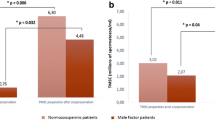Abstract
Purpose
To compare subgroups of the human sperm hypoosmotic swelling test subgroups in both recurrent fertilization negative infertile cases with normal semen analysis and fertilization positive controls.
Methods
This was a prospective case-controlled study performed with normospermic 33 previously fertile male (secondary infertility) and 41 infertile men who had undergone two or three unsuccessful in vitro fertilization attempts. HOS test was investigated in 4 subgroups including HOS 1, HOS 2, HOS 3, and HOS 4 according to the degree of sperm tail swelling and compared between the two groups.
Results
Four subgroups were compared and statistical significance was demonstrated in HOS 1, HOS 3 and HOS 4 tests (p < 0.001) in fertile and infertile men. Highest HOS 1 and lowest HOS 4 grades were determined in Group A. However, no statistical significance was determined between two groups in HOS 2 test which was minimal swelling in sperm tails.
Conclusions
HOS 1, HOS 3 and HOS 4 subgroups of HOS test are reliable and useful methods providing important information regarding the sperm function. A high HOS test 1 grade plus a low HOS test 4 grade should suggest a fertility problem, despite a normal semen analysis. HOS test subgroups provide additional information in normospermic cases with unexplained infertility.

Similar content being viewed by others
References
Rowe PH, Comhaire FH, Hargreave TB, Mellows HJ (1993) WHO manual for the standardized investigation and diagnosis of the infertile couple. Cambridge University Press, Cambridge
Tartagni M, Schonauer MM, Cicinelli E et al (2002) Usefulness of the hypo-osmotic swelling test in predicting pregnancy rate and outcome in couples undergoing intrauterine insemination. J Androl 23:498–502
Tanahatoe SJ, McDonnell J, Goverde AJ, Hompes PG, Lambalk CB (2009) Total fertilization failure and idiopathic subfertility. Reprod Biol Endocrinol 12:3
Buch JP (1993) Advanced sperm function testing. Curr Opin Urol 3:503–508
Jeyendran RS, Van der Ven HH, Perez-Pelaez M, Crabo BG, Zaneveld LJ (1984) Development of an assay to asses the functional integrity of the human sperm membrane and its relationship to other semen characteristics. J Reprod Fertil 70:219–228
Majumdar K, Rajagopalan G, Bupathy A (2001) A study of the hypo-osmotic swelling test of spermatozoa in both fertile and infertile male subjects and its relationship with the standard spermiogram. Indian J Urol 17:156–158
Chan SY, Wang C, Chan ST, Ho PC (1990) Differential evaluation of human sperm hypoosmotic swelling test and its relationship with the outcome of in vitro fertilization of human oocytes. Hum Reprod 5:84–88
Chan SY, Craft IL, Chan YM, Leong MK, Leong CK (1990) The hypoosmotic swelling test and cryosurvival of human spermatozoa. Hum Reprod 5:715–718
Chan SY, Wang C, Ng M, So WW, Ho PC (1988) Multivariate discriminant analysis of the relationship between the hypoosmotic swelling test and the in vitro fertilizing capacity of human sperm. Int J Androl 11:369–378
WHO laboratory manual for the examination of human semen and sperm-cervical mucus interaction (1999). 4th ed, Cambridge University Press, Cambridge
Mordel N, Mor-Yosef S, Margalioth E, Shemesh A, Samueloff A, Schenker JG (1989) The human sperm hypoosmotic swelling test: its practical application and suggestions for improvement. Int J Fertil 34:355–358
Mordel N, Dano I, Epistein-Eldan M, Shemesh A, Schenker JG, Laufer N (1993) Novel parameters of human sperm hypoosmotic swelling test and their correlation to standard spermatogram, total motile sperm fraction, and sperm penetration assay. Fertil Steril 59:1276–1279
Check JH, Katsoff D, Check ML (2001) Some semen abnormalities may cause infertility by impairing implantation rather than fertilization. Med Hypotheses 56:653–657
Check JH, Katsoff D, Check ML, Choe JK, Swenson K (2001) In vitro fertilization with intracytoplasmic sperm injection is an effective therapy for male factor infertility related to subnormal hypo-osmotic swelling test scores. J Androl 22:261–265
Cincik M, Ergur AR, Tutuncu L et al (2007) Combination of hypoosmotic swelling/eosin Y test for sperm membrane integrity evaluation: correlations with other sperm parameters to predict ICSI cycles. Arch Androl 53:25–28
Hossain A, Osuamkpe C, Hossain S, Phelps JY (2010) Spontaneously developed tail swellings (SDTS) influence the accuracy of the hypo-osmotic swelling test (HOS-test) in determining membrane integrity and viability of human spermatozoa. J Assist Reprod Genet 27:83–86
Conflict of interest
We declare that we have no conflict of interest.
Author information
Authors and Affiliations
Corresponding author
Rights and permissions
About this article
Cite this article
Irez, T., Usta, T.A., Zebitay, G. et al. Evaluation of subgroups of the human sperm hypoosmotic swelling test in normozoospermic male cases with recurrent fertilization failure: a prospective case-controlled study. Arch Gynecol Obstet 287, 797–801 (2013). https://doi.org/10.1007/s00404-012-2634-6
Received:
Accepted:
Published:
Issue Date:
DOI: https://doi.org/10.1007/s00404-012-2634-6




